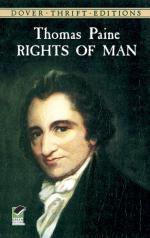
|
| Name: _________________________ | Period: ___________________ |
This test consists of 15 multiple choice questions and 5 short answer questions.
Multiple Choice Questions
1. As Paine wrote, what kind of impact would the French Revolution have?
(a) Only an impact on France.
(b) An impact on France and other countries.
(c) Neither an impact on France nor other countries.
(d) Only an impact on other countries.
2. According to Paine in the Preface, who was his audience for Rights of Man?
(a) Half the world.
(b) The whole world.
(c) A small part of the world.
(d) The western world.
3. Since the people are sovereign, what were the only type of actions that Paine thought should be stopped by the law?
(a) Actions that hurt society or the government.
(b) Actions that remove the government's authority.
(c) Actions that reduce the government.
(d) Actions that hurt society.
4. How did Paine summarize Burke's views in the Miscellaneous Chapter?
(a) Burke did not understand which rights individuals did not have.
(b) Burke did not understand which rights individuals had.
(c) Burke claimed that individuals had only select rights.
(d) Burke claimed that individuals had no rights.
5. Why did Paine think that Burke refused to compare the French and British Constitutions?
(a) The French Constitution was more difficult to understand.
(b) The English Constitution was incomplete.
(c) The French Constitution was better.
(d) The English Constitution was not being applied.
6. In order to prove the senselessness of Burke's position on the monarchy, what did Paine maintain could not be done to individual rights?
(a) They could not be borrowed or annihilated.
(b) They could not be borrowed or transferred.
(c) They could not be transferred or annihilated.
(d) They could not be borrowed, transferred or annihilated.
7. How did Paine think the English government viewed the French Revolution?
(a) He did not comment on their view.
(b) They supported it.
(c) They supported only certain aspects of it.
(d) They did not support it.
8. According to the French Constitution that Paine referred to, how often must the National Assembly be elected?
(a) Every three years.
(b) Every year.
(c) Every four years.
(d) Every two years.
9. Based on Paine's assessment, how were the people's opinion of government changing as a result of the American and French Revolutions?
(a) Irreversibly.
(b) Not quickly enough.
(c) Gradually.
(d) Quickly.
10. In order to clarify an important aspect of the French Revolution, what did Paine say was the intention of the French people?
(a) To rebel against the men themselves, not the principles that empowered tyrants.
(b) To rebel against both the principles that empowered tyrants and men themselves.
(c) To rebel against neither the principles that empowered tyrants nor the men themselves.
(d) To rebel against principles that empowered tyrants, not men themselves.
11. After pointing out the weaknesses of Burke's position, what did Paine indicate about Burke's principle of past English laws?
(a) It contradicted itself.
(b) It defeated itself.
(c) It diminished itself.
(d) It outsmarted itself.
12. Besides English, which other language was Rights of Man published in?
(a) German.
(b) French.
(c) Italian.
(d) Spanish.
13. Which of the following did Paine speak out against in Rights of Man?
(a) Remarks on the Policies of the Allies with Respect to France.
(b) Reflections on the Revolution in France.
(c) Letters on a Regicide Peace.
(d) Thoughts on French Affairs.
14. What did Paine discuss about the French government at the end of Rights of Man?
(a) How it was structured before the Revolution.
(b) How it was structured after the Revolution.
(c) How its structure remained intact after the Revolution.
(d) How it would have been structured without the Revolution.
15. How did Paine intend to defend the rights he wrote about in Rights of Man?
(a) Through comparisons.
(b) Through reason.
(c) Through persistence.
(d) Through justifications.
Short Answer Questions
1. To begin the Preface, what was Paine's response to Burke's lack of support for the French Revolution?
2. In the beginning of Rights of Man, how did Paine describe Burke's pamphlet?
3. Challenging Burke's view that the government had knowledge, what did Paine insist that Burke could not prove?
4. As Paine wrote in Rights of Man, what must each generation set for themselves to avoid being servants of the past?
5. Because of the American and French Revolutions, what was being undermined about the old governments in Paine's opinion?
|
This section contains 696 words (approx. 3 pages at 300 words per page) |

|




